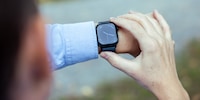
Practical test Fossil Carlyle: Wear OS smartwatch and iPhone: does it work?
How well does a newcomer cope with a smartwatch? The Fossil Carlyle has to pass the practical test together with an iPhone and has a hard time displacing the old wristwatch.
My colleague Rasmus is actually responsible for connecting new suppliers at Galaxus. But he's always wanted to try out a smartwatch. So he was very curious when he spotted the Fossil Carlyle on my desk. It runs on Wear OS from Google and is primarily intended for Android smartphones, but also works with iPhones. Although the Apple Watch is a smartwatch that works better with the iPhone, Rasmus is not dissuaded from trying out the Carlyle. "The Apple Watch is too expensive for me anyway, I would never buy it," was his negative reaction to the Apple product. Incidentally, this was before the launch of the affordable Apple Watch SE, but at the end of the test, Rasmus is not really convinced that he needs a smartwatch.
Wear OS is no problem on the iPhone
The Fossil Carlyle has piqued Rasmus' interest not only because it is a smartwatch, but also because he likes the look of it. He ignored the Skagen Falster, which was also on my desk. The Carlyle's black stainless steel case, paired with a black plastic sports strap, was more appealing. "Looks really smart," he said. And so the enthusiasm in northern Germany is very high. This also applies to the watch's 1.28-inch AMOLED display, which, according to the manufacturer, "is bright enough in sunshine and displays all content clearly." With a case diameter of 44 millimetres, the Fossil Carlyle is one of the larger smartwatches, but is not too big on Rasmus' wrist, but just right.

Setting up the Fossil Carlyle on the iPhone is no problem for Rasmus. He downloads the Wear OS app for iOS and follows the instructions. "Pairing via Bluetooth worked without any problems," reports Rasmus. A pitfall only became apparent later when he tried to answer phone calls via the smartwatch: "I was supposed to do the pairing again for that. But that didn't work." After two complete reinstallations of the app, he gave up and switched off the phone call pairing. We couldn't find an explanation for this afterwards either.
Lots of information, no responses and a weak battery
In everyday life, Rasmus enjoys all the things that a smartwatch has to offer. "I can choose which app can show me notifications. I can also control Spotify and YouTube on my smartphone via the watch." Rasmus also finds it practical that he can see appointments on his wrist.
The fitness functions don't arouse enthusiasm, but at least curiosity. "I don't go jogging, but it's interesting to see on the pedometer how much you move in a day at the office or on a family trip to the amusement park."

He is not happy with the WhatsApp notifications: "I only see the beginning of the message and have to get my smartphone out of my pocket to reply. I can't do that directly via the smartwatch."
The Google Assistant, which can accept voice commands on the Fossil Carlyle, remains unused. "I'm not talking to Siri either," says Rasmus, explaining why he is foregoing the potential convenience that is just one click away in the Wear OS app.

The Fossil Carlyle's biggest sticking point isn't a lack of functions or problems connecting to the iPhone. It's a home-made problem: the battery. Fossil promises 24 hours and even more in economy mode. However, the battery only lasts a day with difficulty: "When I get home after work, the battery is already at the end - without me having used the smartwatch particularly much." A smartwatch that doesn't even last until the end of the day makes little sense for Rasmus.
Conclusion: double vibrations for the time
"I still like the look of the Fossil Carlyle and the connection between Wear OS and iPhone is no problem," Rasmus summarises after several weeks. "The biggest problem is the short battery life of the smartwatch. That doesn't work at all. I could even live with the other minor shortcomings, but not that."
Although the typical smartwatch functions don't seem useful to him: "When I get a notification, I usually take my smartphone out of my pocket after looking at the smartwatch anyway." This is no help and is even annoying, as two devices vibrate with every notification.

His first smartwatch experience has not yet turned Rasmus into a buyer. Even if he now only has to spend around 60 euros / 30 francs more for the Apple Watch SE than for the Fossil Carlyle, he's going back to his old watch for now: "I mostly used the Fossil as a watch and to see what time it is. If I just want to know the time, I get significantly longer battery life from a wristwatch with a quartz movement."
When I was but a young student, I'd sit in my friend's living room with all my classmates and play on his SuperNES. Since then I've had the opportunity to test out all the newest technology for you. I've done reviews at Curved, Computer Bild and Netzwelt, and have now arrived at Galaxus.de.




